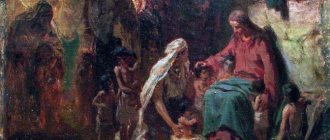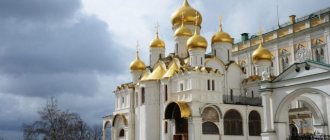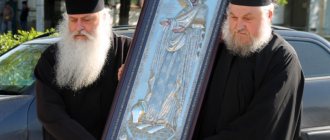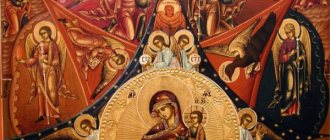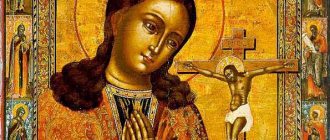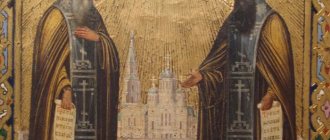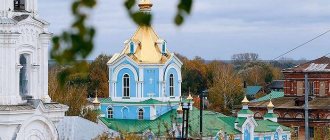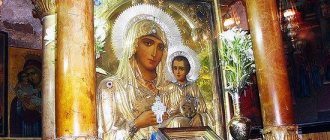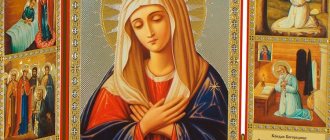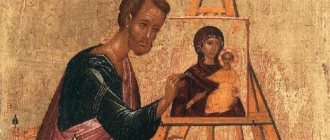Origin story
The Smolensk Icon of the Mother of God appeared in Rus' in the eleventh century. It was transferred from Byzantium to Smolensk after the death of Prince Vsevolod. Previously, with the help of this icon, the prince was blessed to marry the daughter of the Byzantine ruler.
As the legend says, during the Mongol-Tatar yoke, Smolensk was saved from plunder thanks to the protection of the Mother of God. At the beginning of the fifteenth century, during the capture of the city by the Principality of Lithuania, “Hodegetria” was moved from Smolensk to Moscow. In the mid-fifteenth century, the image was returned at the request of Bishop Michael. In Moscow they left an exact copy of the image, handwritten. In the sixteenth century, after Smolensk was taken from Lithuania, the Novodevichy Convent was built in Moscow, in which a copy was placed.
At the beginning of the seventeenth century, another copy was copied from the icon, which was placed in one of the towers of the Smolensk wall. Later a temple was built on this site. During Napoleon's attack, at the beginning of the nineteenth century, the icon was again moved to Moscow. When the French attacked Moscow, the icon was moved to Yaroslavl, and after the war it was again moved to Smolensk, to its original place.
Cathedral of Rostov-Yaroslavl Saints
Agathangel (Preobrazhensky), Yaroslavl, Metropolitan, Spanish: †1928; Oct. 3 || Novomuch. Adrian Poshekhonsky, Yaroslavl, abbot, prmch.: †1550; Mr. 5 ; N. 19 Adrian of Uglich, St.: †after 1504; Av. 26 || All reverend Akakiy Uglichsky, prmch.: †1609; M. 24 Alexander (in schema Alexy) Nevsky, led. prince: †1263; Av. thirty ; N. 23 || Vlad.; Karelian.; Novg.; St. Petersburg; Tul. Alexander Abyssov, priest, schmch.: †1942; F. 8 || Novomuch. Alexander Elokhovsky, priest, schmch.: †1918; Av. 21 || Novomuch. Alexander Pereyaslavsky, bishop: †?; M. 14 Alexander Petropavlovsky, priest, schmch.: †1937; N. 4 || Novomuch. Alexander Pozdeevsky, priest, schmch.: †1940; Oct. 12 || Novomuch. Alexander Smirnov, priest, sschmch.: †1918 || Novomuch. Alexander Uksusov, martyr: †1937; N. 23 || Novomuch. Alexy (Zadvornov), hierome, martyr: †1937; N. 9 || Novomuch. Booth. Alexy Vvedensky, deacon, schmch.: †1937; Av. 13 || Novomuch. Alexy Velikoselsky, priest, schmch.: †1918; Av. 17 || Novomuch. Anastasia Lebedeva, MC: †after 1937; Oct. 29 || Novomuch. Anastasia Uglichskaya, abbess, prmts.: †1609; Ap. 10 Andrey Dobrynin, prot., sshmch.: †1938; F. 8 || Novomuch. Andrei Smolensky, Pereyaslavsky, prince: †after 1390; Oct. 27 || Smolen. Andrei Uglichsky, prince: †1494; N. 6 Andronik (Nikolsky), Perm, archbishop, schmch.: †1918; In. 7 || Novomuch.; Petersburg Anna (Blagoveshchenskaya), nun, prmts.: †1937; F. 26 || Novomuch. Anna Shashkina, mts.: †1939; Ap. 28 || Novomuch. Anthony of Optina, schema-abbot: †1865; Av. 7 || Optin. Anthony of Rostov, bishop: †1336; Il. 28 Antonin Uglichsky, Pokrovsky, abbot, martyr: †1609; M. 24 Arseny (Matseevich), Rostov, metropolitan, sschmch.: †1772; F. 28 || Est. Arseny Uglichsky, prmch.: †1609; M. 24 Afanasy Vysotsky, Serpukhov, Junior, abbot, student of St. Athanasius the Elder: †1395; P. 12 || Moscow; Radonezh. Athanasius of Rostov, Fool for Christ's sake: †XVII Athanasius (Sakharov), Kovrovsky, ep., Spanish: †1962; M. 2 (namesake); Oct. 15 || Novomuch. Afanasy Uglichsky, prmch.: †1609; M. 24 Bogolep of Uglich, hierome: †XVI; Av. 22 Boris (baptized Roman) passion-bearer, prince: †1015; M. 2 ; Il. 24 || Ryaz.; Tul. Boris Zavarin, martyr: †1938; Jan. 25 || Novomuch. Barlaam of Uleimin, Uglich, St.: †after 1460 Barsanuphius of Uglich, Hierom., St.: †1609; M. 24 Vasily Amenitsky, prot., sschmch.: †1938; Av. 7 || Novomuch. Vasily (Vasilko) Konstantinovich Rostov, prince, martyr: †1238; Mr. 4 || Vlad.; Tver. Vasily Vsevolodovich Yaroslavsky, prince: †1249; In. 8 ; Il. 3 Vasily Krylov, priest, schmch.: †1938; N. 6 || Novomuch. Vasily Mangazeisky, martyr: †1600; Mr. 23 ; M. 10 || Siberia Vasily (Preobrazhensky), bishop. Kineshemsky, Spanish: †1945; Il. 31 ; Oct. 5 (acquisition of relics) || Ivan.; Bonfire; Novomuch. Vasily Preobrazhensky, priest, schmch.: †1940; In. 1 || Novomuch. Vasily Yaroslavsky, prince: †1344; Il. 13 Vassian I (Snout) of Rostov, archbishop: †1481; Mr. 23 || Radonezh. Vassian II of Rostov, archbishop: †1516; Jan. 25 Vassian of Uglich, prmch.: †1609; M. 24 Vassian Uglichsky, prmch. (other): †1609; M. 24 Vassian of Uglich, Ryabovsky, St., miracle worker: †1509; F. 12; M. 21; In. 11 Benjamin (Voskresensky), bishop. Romanovsky, schmch.: †1930; P. 22 || Novomuch. Vladimir Vinogradov, priest, schmch.: †1919; D. 9 || Novomuch. Vladimir Vyatsky, priest, schmch.: †1939; P. 26 || Novomuch. Vyacheslav Zakedsky, priest, schmch.: †1918; Av. 10 || Novomuch. Gelasius of Uglich, prmch.: †1609; M. 24 Gennady Zdorovtsev, priest, schmch.: †1918; In. 22 || Novomuch. Gennady Kostromskoy, Lyubimogradsky, prp.: †1565; Jan. 23 ; Av. 19 || Belarusian; Bonfire Gennady (Letyuk), hierome, martyr: †1941; D. 5 || Novomuch. Georgy Sedov, Spanish: †1960; D. 3 || Novomuch. Gerasim Boldinsky, St.: †1554; M. 1 ; Il. 7 (acquisition of relics) || Smolen. Gerasim Uglichsky, archim., prm.: †1609; M. 24 Herman Uglichsky, prmch.: †1609; M. 24 Gerontius of Uglich, pm.: †1609; M. 24 Gleb Apukhtin, priest, schmch.: †1937; P. 10 || Novomuch. Gleb of Rostov, Belozersky, prince: †1280; Il. 24 Grigory (Vorobiev), hierome, martyr: †1937; Oct. 22 || Novomuch. Gregory the Wise, Rostov, archbishop: †1416; M. 3 Gregory of Uglich, pm.: †1609; M. 24 Guriy Uglichsky, pm.: †1609; M. 24 David of Yaroslavl, prince, son of St. Theodore of Smolensk, miracle worker: †1321; Mr. 5 ; In. 22; P. 19 || Smolen. Daniil Grekhozarutsky (Uglichsky), abbot, martyr: †1608; Oct. 1 Daniil Pereyaslavsky, archim.: †1540; Ap. 7 ; Il. 28; D. 30 Demetrius Voznesensky, priest, schmch.: †1918; Oct. 4 || Novomuch. Dimitry Kazansky, priest, schmch.: †after 1937; Il. 4 || Novomuch. Demetrius of Prilutsky, Vologda, abbot, St.: †1392; F. 11 ; In. 3 || Volog.; Radonezh. Demetrius of Rostov (in the world Daniil Savvich Tuptalo), Metropolitan: †1709; P. 21 ; Oct. 28 || Siberia Dimitry Smirnov, prot., schmch.: †1940; In. 13 || Novomuch. Dimitri Uglichsky, prince: †1591; M. 15 ; In. 3 ; Oct. 19 || Moscow Dimitry of Uglich, Prilutsky, prince: †after 1540; M. 19 || Volog. Dionysius the Greek, Rostov, archbishop: †1425; Oct. 18 Dionysius of Pereyaslavl, St.: †1645; Ap. 15 || Vlad. Dorotheus of Yug, Yaroslavl, St.: †1622; In. 5 || Pskovo-Pech. Evgeny Elkhovsky, priest, schmch.: †1937; Oct. 16 || Novomuch. Evgeny Popov, priest, schmch.: †1937; P. 10 || Novomuch. Euthymius of Uglich, hierome, martyr: †1609; M. 24 Elisha of Radonezh, hierodeacon, disciple of St. Sergius of Radonezh: †XIV; In. 14 || Radonezh. Epiphanius the Wise, Radonezh, St., disciple of St. Sergius of Radonezh: †1418-1422; M. 12 || Radonezh. Ephraim of Rostov, archbishop: †1454; Mr. 27 Jacob Arkhipov, priest, schmch.: †1937; Av. 13 || Novomuch. Jacob of Rostov, bishop: †1391; N. 27 Ignatius of the Caucasus (in the world Dmitry Alexandrovich Brianchaninov), bishop: †1867; Ap. 30 || Bonfire; Petersburg Ignatius Lomsky, Yaroslavl, St.: †1591; D. 28 Ignatius of Rostov, ep.: †1288; M. 28 Hierotheus (Glazkov), hierome, prmch.: †1937; Av. 22 || Novomuch. Hilarion of Uglich, pm.: †1609; M. 24 Hilarion of Uglich, martyr. (other): †1609; M. 24 Hilarion of Yuga, St.: †XVIII; In. 5 Elijah Danilovsky, Yaroslavsky, Fool for Christ's sake: †1st half. XVII Joachim of Shartomsky, St.: †ser. XVII John of Vilensky, priest, schmch.: †1918; Oct. 28 || Novomuch. John the Hairy, the Merciful, Rostov, Fool for Christ's sake, wonderworker: †1580; S. 3 ; N. 12 John Dunaev, priest, schmch.: †1938; F. 26 || Novomuch. John Korotkov, martyr: †1941; P. 17 || Novomuch. John Myrotvortsev, priest, schmch.: †1938; Mr. 5 || Novomuch. John of Moscow, Big Cap, Fool for Christ's sake: †1589; In. 12; Il. 3 || Volog.; Moscow John Plekhanov, priest, schmch.: †1938; Mr. 12 || Novomuch. Booth. John Rudinsky, priest, schmch.: †1930; Oct. 29 || Novomuch. John Smirnov, priest, schmch.: †1937; Oct. 24 || Novomuch. John Talyzin, priest, schmch.: †1937; Oct. 20 || Novomuch. John (monastically Ignatius) of Uglich, Vologda, Prilutsk, prince, schema: †1523; M. 19 ; D. 28 || Volog. John of Uglich, infant, martyr: †1663; In. 25 John of Uglich, prom.: †1609; M. 24 Job of Moscow and All Rus', patriarch: †1607; Ap. 5 ; In. 19 || Moscow St.; Tver. Job of Uglich, prmch.: †1609; M. 24 Job of Uglich, martyr. (other): †1609; M. 24 Jonah of Uglich, pm.: †1609; M. 24 Joseph (Baranov), hierome, martyr: †1918; Av. 8 || Novomuch. Joseph of Uglich, pm.: †1609; M. 24 Joseph of Uglich, martyr. (other): †1609; M. 24 Iraida Tikhova, Spanish: †1967; Il. 25 || Novomuch. Irinarch (in the world Elijah) of Rostov, recluse: †1616; Jan. 13 Isaac of Lomsky, St.: †con. XVI - beginning XVII; D. 28 Isaiah of Rostov, bishop, wonderworker: †1090; M. 15 Isidor Tverdislov, Rostov, fool for Christ, wonderworker: †1474; M. 14 Judas of Uglich, martyr: †1609; M. 24 Cassian the Greek, Uglich, St., wonderworker: †1504; M. 21 ; Oct. 2 Cyprian Tropsky, Yaroslavl, St.: †to mid. XVI Kirill Borisoglebsky, schema.: †? Cyril of Radonezh, schema, father of St. Sergius of Radonezh: †until 1337; Jan. 18 ; P. 28 || Radonezh. Kirill of Rostov, ep.: †1262 Kirill of Rostov, ep.: †1384 Konstantin Vsevolodovich Yaroslavsky, prince: †1257; In. 8 ; Il. 3 Konstantin Snyatinovsky, priest, schmch.: †1918 || Novomuch. Konstantin Yaroslavsky, prince, son of St. Theodore of Smolensk, miracle worker: †before 1321; Mr. 5 ; In. 22; P. 19 || Smolen. Cornilius of Pereyaslavl, St.: †1693; Il. 22 Cosmas of Uglich, prmch.: †1609; M. 24 Leonid Poshekhonsky, Venerable, student and associate of Venerable. Adriana: †1549; Mr. 5 Leonty of Rostov, bishop, schmch.: †1073; M. 23 Leonty of Uglichsky, prmch.: †1609; M. 24 Luke (Voino-Yasenetsky), Simferopol, archbishop, Spanish: †1961; M. 29 || Kursk; Novomuch. Luke of Rostov, bishop: †1189; N. 10 Macarius of Uglich, prmch.: †1609; M. 24 Macarius of Uglich, martyr. (other): †1609; M. 24 Mamant Uglichsky, prmch.: †1609; M. 24 Mardariy (Isaev), hierome, martyr: †1938; Mr. 5 || Novomuch. Maria Danilova, MC: †1946; D. 30 || Novomuch. Maria (Korepova), nun, Spanish: †after 1942 || Novomuch. Maria of Radonezh, schema-nun, mother of St. Sergius of Radonezh: †until 1337; Jan. 18 ; P. 28 || Radonezh. Markell of Uglich, prmch.: †1609; M. 24 Matthias of Uglich, pm.: †1609; M. 24 Mikhail Belorossov, prot., sschmch.: †1920; M. 11 || Novomuch. Mikhail Borisov, prot., schmch.: †1942; M. 22 || Novomuch. Mikhail Gorbunov, priest, schmch.: †1938; F. 22 || Novomuch. Mikhail Zelentsovsky, priest, schmch.: †1937; N. 26 || Novomuch. Mikhail Rozov, priest, Spanish: †1941; Jan. 8 || Novomuch. Mikhail Uglichsky, prmch.: †1609; M. 24 Moses of Optina, schema-archim.: †1862; In. 16 || Optin. Nikita the Stylite, Pereyaslavsky, St., miracle worker: †1186; M. 24 || Vlad. Nikander (Prusak), hierome, prmch.: †1918; In. 17 || Novomuch. Nikita Uglichsky, prmch.: †1609; M. 24 Nikifor Uglichsky, prmch.: †1609; M. 24 Nikodim (in the world Nikita) Kozheezersky, Khozyugsky, St.: †1640; Il. 3 ; Oct. 31 || Novg. Nikodim (Krotkov), Kostroma, archbishop, schmch.: †1938; Av. 8 || Bonfire; Novomuch. Nikolai Bryantsev, priest, schmch.: †1919; In. 25 || Novomuch. Nikolai Vinogradov, prot., Spanish: †1948; N. 18 || Novomuch. Nikolai Dunaev, priest, schmch.: †1937; N. 14 || Novomuch. Nikolai Ershov, priest, schmch.: †1937; D. 3 || Novomuch. Nikolai Lyubomudrov, priest, schmch.: †1918; Oct. 20 || Novomuch. Nikolai Nikolsky, priest, schmch.: †1937; Oct. 24 || Novomuch. Nikolai Orlov, priest, schmch.: †1937; Av. 13 || Novomuch. Nikolai Pisarevsky, priest, Spanish: †1933; Ap. 21 || Novomuch. Nikolai Pongelsky, priest, schmch.: †1942; Il. 24 || Novomuch. Nikolai Rozin, priest, sschmch.: †1930 || Novomuch. Nikolai Rozov, priest, schmch.: †1930; Mr. 7 || Novomuch. Nikolai Rozov, prot., Spanish: †1941; P. 25 || Novomuch. Nikolay Rozov, prot., sshmch.: †1938; D. 10 || Novomuch. Nikolai Ushakov, priest, schmch.: †1937; Oct. 22 || Novomuch. Onisim of Radonezh, St., goalkeeper, student of St. Sergius of Radonezh: †XIV; F. 15 || Radonezh. Onufry Romanovsky, Yaroslavsky, Fool for Christ's sake: †?; In. 12 Onufriy Uglichsky, pm.: †1609; M. 24 Pavel Rostovsky, Borisoglebsky, abbot: †after 1409; Oct. 22 || Radonezh. Pavel Uspensky, priest, schmch.: †1938; Jan. 17 || Novomuch. Paisiy Uglichsky, abbot: †1504; Jan. 8 ; In. 6 || Tver. Peter Bogorodsky, priest, schmch.: †1938; Oct. 24 || Novomuch. Peter Grigoriev, priest, schmch.: †1937; P. 10 || Novomuch. Peter Zefirov, priest, schmch.: †1918; Il. 10 || Novomuch. Peter Ordynsky, Rostov, Tsarevich, St.: †1290; In. 30 Peter Popov, priest, schmch.: †1937; M. 12 || Novomuch. Peter Tokarev, priest, schmch.: †1937; Av. 7 || Novomuch. Peter Favoritov, deacon, schmch.: †1931 || Novomuch. Pimen of Rostov, recluse and verizhnik: †XVII; Av. 26 Polievkt Uglichsky, prmch.: †1609; M. 24 Prokhor (in schema Tryphon) Rostov, ep.: †1328; P. 7 Roman Uglichsky, prince: †1285; F. 3 Sevastian Sokhotsky, Poshekhonsky, St.: †approx. 1500; F. 26 ; D. 18 Serapion of Uglich, pm.: †1609; M. 24 Seraphim Vyritsky, St.: †1949; Mr. 21 || Petersburg Seraphim (Samoilovich), Uglich, archbishop, sschmch.: †1937; Oct. 22 || Novomuch. Sergius Zavarin, priest, schmch.: †1938; Ap. 1 || Novomuch. Sergius Mechev, prot., schmch.: †1942; D. 24 || Moscow; Novomuch. Sergius of Pereyaslavsky, schema., Fool for Christ's sake: †1st half. XVII Sergius of Radonezh, abbot, wonderworker of all Russia: †1392; Il. 5 ; Av. 24 ; P. 25 || Vlad.; Moscow; Radonezh. Sylvester of Obnor, Poshekhonsky, St., miracle worker, disciple of St. Sergius of Radonezh: †1379; Ap. 25 || Radonezh. Simeon of Uglich, pm.: †1609; M. 24 Simon of Rostov, ep.: †1st half. XII Stefan of Moscow, St., brother of St. Sergius of Radonezh: †XIV-XV; Il. 14 || Moscow; Radonezh. Stefan of Perm (Great Perm), ep.: †1396; Ap. 26 || Volog.; Moscow; Radonezh. Stefan of Rostov, Fool for Christ's sake: †ok. 1592 Tikhon, Patriarch of Moscow and All Rus', Spanish: †1925; Mr. 25 ; P. 26 || Moscow St.; Novomuch.; Petersburg Tikhon of Uglich, prmch.: †1609; M. 24 Trifon of Rostov, ep.: †1468; F. 1 Thekla (in the world of Theodosius) Pereyaslavskaya, Venerable, mother of Daniel of Pereyaslavl: †XV-XVI; Ap. 7 Theodore of the Epiphany, priest, Spanish: †1933; Jan. 28 || Novomuch. Feodor Poroikov, prot., sshmch.: †1938; D. 22 || Novomuch. Theodore Rostislavich Cherny, Smolensky, Yaroslavl, prince, wonderworker: †1299; Mr. 5 ; In. 22; P. 19 || Smolen. Theodore of Rostov, archbishop, nephew of St. Sergius of Radonezh: †1394; N. 28 || Radonezh. Theodore of Rostov, Borisoglebsky, abbot: †1409; Oct. 22 || Radonezh. Theodore of Sanaksar, hierome: †1791; F. 19; Ap. 21 (acquisition of relics) Theodore Ushakov, Sanaksarsky, admiral, nephew of St. Theodore of Sanaksar, rights: †1817; Il. 23 (glorification); Oct. 2 Theodore of Suzdal, bishop, wonderworker: †1023; In. 8 ; Av. 20 || Vlad. Theodosius of Uglich, prmch.: †1609; M. 24 Filaret (in the schema of Theodosius, Amphitheaters) of Kiev, Metropolitan: †1857; D. 21 || Bryansk; Pecher., far; Ryaz.; Siberia Filaret of Moscow (in the world Vasily Mikhailovich Drozdov), Metropolitan: †1867; N. 19 || Moscow St.; Petersburg Filaret of Uglich, prmch.: †1609; M. 24 Flegont Pongilsky, prot., sschmch.: †1938; Ap. 10 || Novomuch. Christopher Uglichsky, pm.: †1609; M. 24 1000 martyrs of Uglich: †1609; M. 24,200 martyrs of Grekhozarutsky (Uglich), with martyrdom. Daniil Grekhozarutsky: †1608; Oct. 1 30 Venerable Martyrs of Sin (Uglich): †1608; Oct. 1 35 Holy Martyrs of Uglich, with Primts. Anastasia Uglichskaya: †1609; Ap. 10
Meaning in Orthodoxy
The Icon of the Most Holy Theotokos “Hodegetria of Sedmiezernaya” is considered one of the most important Orthodox shrines. Her history of movements across the Russian Land is directly intertwined with the most important events in the history of the state. Therefore, this icon is also called the “Guide”. It is believed that “Hodegetria” is an intercessor; it was she who protected our people from predatory invasions.
What do they ask for and what does the image help with?
Since “Hodegetria” is considered an intercessor, believers pray to this image to receive protection. Be it protecting the state from invasions and military operations, or protecting loved ones from illness and protecting family happiness.
Protection from hostilities
It is believed that it was thanks to the miraculous help of Our Lady of Smolensk that the Russian land was saved from invaders during the largest war in its history.
Before the icon was transferred to Russia, she defended the Byzantine state in the same way.
Protection of army personnel and sailors
Those serving in the army and navy, as well as their loved ones, pray to “Hodegetria” for protection and patronage in the event of hostilities.
Protects against diseases and epidemics
In addition to protection from military threats, the holy image helps against various diseases and epidemics.
Keeps family happiness
People in a marriage relationship ask “Hodegetria” for protection and protection of the family union and happiness within the family, as well as protection from any outside influences that could destroy the sacred union.
Patronage of family people
“Hodegetria” is considered the intercessor of family people. She helps with any requests and protection of family well-being.
June 5 (May 23) Cathedral of Rostov-Yaroslavl Saints and Wonderworkers of Rostov - Leonty, Isaiah, Ignatius, Jacob, Theodore, Demetrius, Arseny; Abraham the Archimandrite, Peter the Prince of Horde, Blessed John the Hairy the Merciful, Irinarch the Recluse, Blessed Isidore, Prince Vasilko; Yaroslavl miracle workers - the noble princes Vasily and Constantine, Theodore and his children David and Constantine; Pereslavl miracle workers - St. Nikita the Stylite, Daniel, Blessed Prince Andrei, Blessed Grand Duke Alexander Nevsky; Uglich miracle workers - the passion-bearer of the blessed prince Tsarevich Dimitri, the venerables Ignatius, Cassian, Paisius, the blessed prince Roman; Poshekhonsky miracle workers - Saints Adrian and Sebastian, Sylvester of Obnorsky, Gennady of Lyubimograd and Kostroma.
Troparion to the Saints of Rostov, tone 4
Holy Wisdom, teachers of your flock enlightening God, multiplying the faith of the Gospel in people, creating worthy images of Heavenly love on earth, the people of the country of Rostov and Yaroslavl having shared salvation, truly serving God and being partakers of the apostles, worthy ones appeared in nature, Leontius the Hieromartyr, Isaiah, Ignatius , Jacob, Theodore and Demetrius of Russia, pray to Christ God for the bishops, for your successors on the throne, for the people who reverence you piously, for our Orthodox country and for the entire Church of Christ.
Troparion, ch. 4
O pious council, / O chosen people, / Hierarchs, reverend and righteous, / and good-believing citizens of Russia, / like stars in the firmament of the church / of the country of Rostov and Yaroslavl, intercession to God, / we magnify you with love, our relatives according to the flesh. / You pray to grant peace to our country and our Church, / God’s blessing and mercy to all people, / forgiveness and salvation, / for you are intercessors for us in dreams of the Holy Trinity.
Prayer to the saints of the lands of Rostov and Yaroslavl
O holy saints of God, God's friends, men of Christ, saints and reverends and all, glorify the Church! Those who preached the Gospel in word and life, fought a good fight in the lands of Rostov and Yaroslavl, and naturally received in heaven the crown of righteousness, which the Lord has prepared for all who love Him. In the same way, looking at your holy image, we rejoice at the glorious end of your life and honor your holy memory. You, standing before the Throne of God, accept our prayers and bring them to the All-Merciful God, to forgive us every sin and help us against the wiles of the devil, so that, having been delivered from sorrows, illnesses, troubles and misfortunes and all evil, we will live piously and righteously in the present and through your intercession we will be worthy, even though we are unworthy, to see good on the land of the living, glorifying the one in our saints, the glorified God, the Father and the Son and the Holy Spirit, now and ever and unto the ages of ages.
Amen
Prayer to Saint Leonty, Bishop of Rostov
O sacred head, glorious miracle worker, chief shepherd of the holy Rostov Church, Saint Father Leonty! We fall down and pray to you, humble and sinful, and, like a father who loves his children, we ask: instill in our hearts your love, with which you were filled with God and your neighbors during your life, as you laid down your soul for your flock, having suffered martyrdom from idolaters, teach us, Father, to imitate you faithfully, to love God and our neighbors sincerely and to fulfill the Lord’s commandments without sin, so that we too may be your children not only in name, but in our deeds and in all our lives. Pray, servant of God, to Christ God for the holy Orthodox Church and the Russian state: may they remain in peace and prosperity and prosper in piety as unshakable Christians. Keep your city of Rostov and all the cities and towns of the Russian country unharmed from all evil. Look kindly upon every Christian soul who seeks mercy and help from you, be a healer to all of us in sickness, a comforter in sorrow, a deliverer in sorrow, a helper in troubles, a mortal patron in the hour; May we, sinners, be worthy to receive eternal salvation and inherit the Kingdom of Christ with the help of the prayers of your saints. Hey, Saint of Christ! do not disgrace our hope, which according to God and the Most Holy Theotokos we firmly place on you, but show us your powerful intercession, so that we praise, glorify and magnify the great love for mankind in His saints, God the Father, and the Son, and the Holy Spirit, forever and ever.
Amen.
Days of Honor
The Smolensk Icon of the Mother of God “Hodegetria” has three days of celebration. Each of these days, in one way or another, is connected with major events in the history of the Russian state, which are intertwined with the movements of the icon itself on Russian soil.
10th of August
On the tenth of August every year the day of veneration of “Hodegetria” is celebrated. This day is associated with the movement of the icon from the Annunciation Cathedral to the newly built Novodevichy Convent in Moscow in connection with the liberation of Smolensk from the rule of the Lithuanian state at the beginning of the sixteenth century. The monastery itself was built in honor of the Mother of God, in honor of the city’s deliverance from invaders.
November 18th
The memorable date corresponding to the eighteenth of November was established at the beginning of the nineteenth century, immediately after the liberation of Russian soil from the French invaders. It is believed that it was thanks to the prayers of the Russian people “Hodegetria” that the Russian Empire was liberated from Napoleon’s invasion.
December 7
Another day of veneration is the seventh of November or the twenty-fourth of November according to the old style. This date is dedicated to the celebration of the liberation of the Smolensk land from the Tatar-Mongol invasion. Thanks to the miraculous icon of the Mother of God, Smolensk was protected from invaders.
Yaroslavl Icon of the Mother of God
Orthodoxy has many icons, most of them dedicated to the Mother of God and Jesus Christ, depicted as a baby. The Yaroslavl Icon of the Mother of God is no exception.
This is one of the icons that you should definitely have in your home. It will protect you and will be an excellent image for prayer. In a word, the Yaroslavl Icon of the Mother of God is suitable for any family. You can place it anywhere - in the bedroom or in the kitchen above the dining table. The main thing is that you believe in its great power and grace, for without faith there is no salvation.
History of the icon
The Yaroslavl icon of the Mother of God is inseparably connected with the Yaroslavl land. Back in the 13th century, the Church of the Assumption of the Virgin Mary was built in Yaroslavl district. To this day, this temple is the main one in the entire region.
Almost from the very beginning, this cathedral contained the “Tenderness” icon, which depicts the Virgin Mary with Jesus Christ, who reaches out to the Mother and touches her cheek. This image has been slightly changed, but its very essence has been preserved. This icon became a kind of happy talisman of Yaroslavl and its lands, its holy, miraculous banner. This icon expresses the love of the Mother for the Son. This is a very beautiful image that represents love for all people.
The arrival of the icon in Yaroslavl took place during a difficult period for Rus' - during the Tatar-Mongol invasion. She saved our people from even greater troubles than they saw then. Enemy troops ravaged cities and left behind only rivers of blood and suffering. The Yaroslavl icon protected the inhabitants of Yaroslavl and in the final stages of this terrible period became a symbol of the fight against evil.
Where the icon came from remains a mystery, despite the opinions of scientists about the Vladimir or Kiev origin of the image. Now the oldest copy of this icon still remains in its original place - in the Yaroslavl Assumption Cathedral.
Icon Veneration Day
The day of celebration of the icon is June 21. Every year in all churches they remember the noble princes Vasily and Constantine, thanks to whom Rus' saw this icon and fell in love with it.
What does the Yaroslavl icon help with?
The icon more than once healed people from blindness and serious illnesses, for which it received a special status. It was always carefully preserved, it was always admired. The Yaroslavl icon is still considered the guardian of the hearth and the health of the people living in the house.
Most often, the icon is placed in the kitchen, above the dining table. It is to this icon that people pray before meals, after meals, and to ask for healing.
The clergy note that it does not always make sense to read full prayers. It is enough to simply sincerely ask the Lady and Child Jesus for what you need most. This icon is prayed to on the Dormition, the Annunciation and other holidays associated directly with the Mother of God. Among the prayers, we should highlight “Virgin Mother of God, Rejoice” and “Creed.” These are the main prayers that should be read before the Yaroslavl image of the Mother of God, although there are no strict rules in this regard.
The icon will help you maintain good health and get sick less often. Remember that the most important thing is faith and purity of soul.
Prayer before the Yaroslavl Icon of the Mother of God
“To the chosen Voivode, victorious, delivering us from all evil, grateful, we praise You, Mother of God, for making your people invincible, free from all troubles, and we call You: Rejoice, Queen of Heaven. Glorious Ever-Virgin, Mother of Christ God. Bring our prayer to Your Son and our God, that You may save our souls. I place all my hope in You, Mother of God, keep me under your roof. Virgin Mary, do not abandon me, a sinner who requires Your help and Your intercession, my soul trusts in You, awaits mercy from You.”
Try to pray to the icon not only in difficult and dark periods, but also in bright times, when everything is fine with you, because true prayer is the one that is dedicated to thanksgiving, for a friend is only the one who stays with us in warm and bright times, and does not come for help in the impenetrable darkness. Always remember that gratitude and forgiveness are the epitome of faith. You can expect help from God and the Mother of God without prayers, because the Lord always helps good people and rewards everyone according to their deeds and thoughts.
Let this image of the Yaroslavl Mother of God become your chosen one. If you want your home to be filled with good luck, happiness and light, then do not forget to pray for the coming sleep in the morning, and also place icons at home that have protected people for many centuries.
Lyrics
Below are excerpts of church hymns dedicated to “Hodegetria,” as well as the texts of prayers that are customary to address to the Smolensk icon of the Most Holy Theotokos.
Troparion
“Now we are diligent to the Mother of God, sinners and humility, and let us fall, in repentance calling from the depths of our souls: Lady, help us, having had mercy on us, struggling, we are perishing from many sins, do not turn away your slaves, for you are the only hope of the imams.
Glory, even now, to the Mother of God
Let us never be silent, O Mother of God, to speak Your strength unworthy. If You weren’t there to pray, who would save us from so many Vedas? Who would have kept them free until now? We will not retreat, O Lady, from You: for Your servants always save You from all evil ones.”
Kontakion
“The representation of Christians is unshameful, / intercession to the Creator is immutable, / do not despise the voices of sinful prayers, / but advance, as the Good One, to the aid of us, / faithfully calling Ty: / hasten to prayer and sweat asking for supplication, // interceding everlastingly, the Mother of God, those who honor Thee."
“We are not the imams of other help, / are not the imams of other hope, / unless You, Lady, / help us, / we rely on You, / and we boast in You, / for we are Your servants, / / let us not be ashamed.”
Prayer
It is customary to pray to the Smolensk icon of the Blessed Virgin Mary with a request for protection and patronage, both in family matters and in state affairs, as well as in any professional activity.
First
“To whom shall I cry, Lady? To whom shall I turn in my grief, if not to You, Queen of Heaven? Who will hear my cry and receive my sighs, if not You, Most Immaculate, the Hope of Christians and the Refuge for us sinners? Who will protect them more than You in misfortune? Hear my groaning and incline Your ear to me, the Lady and Mother of my God. Do not despise the one who seeks Your help and do not reject me, a sinner, Queen of Heaven! Teach me to do the will of Your Son and grant me the desire to always follow His holy commandments. For my murmur in illnesses, labors and misfortunes, do not retreat from me, but be the Mother and Patroness of the less cowardly, my Most Gracious Queen, Zealous Intercessor!
Through your intercession, cover my sins, protect from visible and invisible enemies, soften the hearts of those at war against me and warm them with Christ’s love. Grant to me, who is weak, Your all-powerful help to overcome my sinful habits, so that, cleansed by repentance and subsequent virtuous life, I may spend the rest of my days on earth in communion with the Holy Church. th journey. Stand before me, Hope of all Christians, at the hour of my death and strengthen my faith in the difficult hour of death. Offer up your all-powerful prayers for me, who have sinned many times in this life, after my departure, that the Lord will justify me and make me a partaker of His endless joys. Amen".
Second
“To whom shall I cry, Lady? To whom shall I turn in my grief, if not to You, Lady Lady Theotokos, Queen of Heaven? Who will accept my cry and my sighing, if not You, O Most Immaculate One, Hope of Christians and Refuge for sinners? Incline, O Most Pure Lady, Your ear to my prayer, Mother of my God, do not despise me, requiring Your help, hear my groaning and inspire the cry of my heart, O Lord aka the Mother of God Queen. And grant me spiritual joy, strengthen me, who is impatient, sad and careless towards Your praise. Understand and teach me how it is fitting for You to pray, and do not depart from me, Mother of my God, for my grumbling and impatience, but be my protection and intercession in my life and bring me to the quiet haven of blessed peace, and count me to your face Your chosen flock and there deign me to glorify and glorify You forever. Amen".
Iconography and temples of St. Blagv Prince Theodore, David and Constantine of Yaroslavl
Holy blessed princes Theodore, David and Konstantin of Yaroslavl. Con. XV century Rostov lands (Yaroslavl?). 62.2 × 49.6 × 2.7. Wood (linden), two boards, two mortise one-sided dowels, ark, pavolok, gesso, tempera. The centerpiece and margins of the icon in ancient times were covered with a continuous basma frame, traces of the attachment of rims and tsat.
Origin unknown. Purchased for the museum in 2008 in Yaroslavl. Previously: collection of V. M. Momot (Moscow).
Disclosed in 2008 by V. M. Momot.
The base in the upper parts has several cracks, including a through one in the right board with the loss of the author's painting, filled with new tinted primer. The same inserts are at the joint of the boards, above Constantine’s halo, in the lower part of the soil. Numerous minor losses of paint layer, restoration repairs, tinting. In the places where the solid basma flashing, rims and tsat are attached there are significant soil chips. The painting is very worn.
The image of the holy prince of Smolensk and Yaroslavl Theodore with his sons David and Constantine, in accordance with the tradition of Russian princely iconography, represents a kind of triple portrait of the ruler-father with two children - heirs to the throne. The compositional scheme goes back to the image of the Kyiv prince Vladimir with his sons Boris and Gleb, but is also known from the image of the Murom wonderworkers Constantine with the princes Mikhail and Theodore. The iconography of the “triads” of the Kiev, Yaroslavl and Murom princes, associated with the sacred symbolism of the number three, corresponded to liturgical texts in which the triple union of father and sons was glorified as a “wonderful trinity” of saints, “reflecting the trisolar light”, “three together shining like the sun” .
Iconographic portraits of the holy Yaroslavl princes appeared only in 1563–1564: fresco images in the Spaso-Perobrazhensky Cathedral of the Yaroslavl Monastery, the Archangel Cathedral of the Moscow Kremlin, as well as similar middles of two simultaneously painted hagiographic icons from the YaMZ collection, including a temple one from the local row of the iconostasis Spassky Cathedral in 1564. They all vary the same iconography: in the center stands the blessing Prince Theodore in a schema (sometimes with a scroll), placing his hand on the shoulder of his youngest son. On both sides are depicted the small figures of the young princes David and Constantine, close to their father, turning towards him with hands folded in prayer, in princely robes, but devoid of any attributes of princely power. The creation of a whole series of solemn images of the Yaroslavl wonderworkers Theodore, David and Constantine with lives and miracles, apparently, is associated with the beginning of the all-Russian glorification of saints, whose lives in the middle of the 16th century. was included in the royal list of the Great Mena of the Four and was highly revered by Ivan the Terrible.
The published icon belongs to another, the most ancient iconographic tradition: the full-length figures of the holy princes, presented strictly frontally, repeat the characteristic type of tombstone image and go back to the composition of the sewn cover of 1501 with the reliquary of the incorruptible relics of the wonderworkers. The burial of three princes in one coffin, noted by the chronicler when their relics were found, predetermined the unusual composition of the cover. The strongly elongated and closely spaced figures of the saints and the monastic image of Theodore, much taller than his sons, exactly correspond to the words of an eyewitness to the event of 1463: “The three great princes were lying, Prince Theodore Rostislavich and his children... lying on top of the ground. Prince Fyodor himself was great... he was tall, and both Kostyantin and Davyd lay under his bosoms, even smaller than his height... in a single coffin.”
On the icon in question, as well as on the cover, the figures of the princes are painted separately: Theodore blessing him in the monastic schema, with a scroll, David and Constantine in princely fur coats thrown over their shoulders, and hats trimmed with fur, and with swords in their hands, emphasizing the high princely the dignity of those depicted. This lost in the 16th century. a feature indicating recognition of the power of the Yaroslavl princely family could appear and be maintained only in the last years of the existence of the princely throne. In subsequent centuries, none of the numerous images of Saints Theodore, David and Constantine contain this detail; swords are not mentioned in the descriptions of iconographic originals, the texts of which almost completely preserved the chronicler’s vivid story.
On the published icon both brothers are depicted as very young, innocent youths. The symmetry of the figures is enhanced by the color of their clothes, varying the same colors. The small size of the ancient icon indicates the composition of the first iconography of the saints before their official canonization. It should be noted that in Rus' the tradition of small gravestone icons was known: images of the same size (approx. 65 × 50 cm) stood at the tombs of the Volotsk princes Ivan and Fyodor Borisovich at the beginning of the 16th century. in the Assumption Cathedral of the Joseph-Volokolamsk Monastery and were paired portraits of the buried and their heavenly patrons.
The time of creation of the published icon is no later than the end of the 15th century, which allows us to see in it one of the first, if not the earliest, images of the Yaroslavl miracle workers, close to the time of their glorification. The process of canonization of saints usually included several stages, but only with the advent of the hagiographic text and the liturgical canon intended for execution on the day of church remembrance, an embroidered portrait cover was placed on the shrine, and a funerary icon depicting the saint was placed next to the relics. In the Transfiguration Cathedral, such a memorial complex appeared no earlier than the late 1480s–1490s, as evidenced by the ancient cover with the image of Saints Theodore, David and Constantine, the sewing of which began no earlier than the late 1490s. and ended with the solemn laying of it in 1501. The first funerary icon of the miracle workers should also be dated to this time. Most likely, the monument being published is one of her replicas (perhaps made for the Rostov bishop?), although it cannot be ruled out that it was intended to decorate the tomb of the newly-minted saints. The fact that in ancient times this was a revered image is evidenced by the rich setting that once adorned it: silver basma, crowns, tsats.
The stylistic features of the icon suggest the Rostov origin of the master. This is evidenced by light, elongated and slender figures with soft streamlined silhouettes and clearly defined contours on a light yellow background, sparse and straight draperies of clothes with pointed and angular shapes, translucent liquid paints, but especially the color typical of Rostov painting, based on blue, brown, soft red and yellow colors. The monument reveals a close stylistic resemblance to the “Archangel Michael” icons of the last quarter of the 15th century. from the GMZRK and “Boris and Gleb” from the collection of A.I. Anisimov (Tretyakov Gallery), consonant with it in the proportional, coloristic and figurative structure of fragile and slightly angular figures. The character of the dark personal letter, distinguished by an even olive sankir and dense ocher, without the use of spaces, goes back to the techniques of the masters of Deesis icons of the mid-15th century. from the Church of Paraskeva Pyatnitsa on Vspolye in Yaroslavl (YAM). Especially the style of execution of the faces of the Yaroslavl wonderworkers is close to the paleos figures on the end-of-the-century icon “Our Lady Hodegetria with Selected Saints” from the Church of St. Basil the Great in Uglich (YAM). The images are similar not only to the nature of the olive-ocher modeling, but also to the characteristic pattern. Based on materials from the website “Museum of Russian Icons”.
